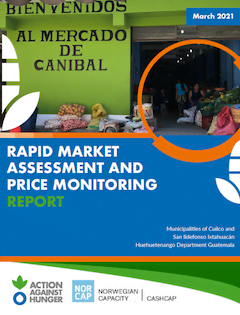Rapid Market Assessment and Price Monitoring Report – Huehuetenango Department Guatemala
Methodology:
This rapid assessment of markets and prices was based on an adapted version of the IFRC’s Rapid Assessment for Markets, elements of the EMMA toolkit’s market system approach and the consortium of NGO’s price monitoring format. The methodology was chosen to give a basic and rapid snapshot of the capacity of markets to provide people with food products in the aftermath of hurricanes Eta and Iota and a context of Covid 19 epidemic and chronic food insecurity.
Assessment objectives:
1.To conduct a rapid price data collection at community and household level to inform food basket and potential transfer values.
2. To assess the response capacity of markets, including the level of supply and diversity following hurricanes Eta and Iota and the ongoing Covid-19 pandemic.
3 .To better understand the level of risks in markets, and to draw conclusions on the appropriateness of market-based interventions in the context of Covid-19.
4. To support data analysis on appropriate and feasible modalities of assistance to support crisis-affected population.
Executive Summary of results and recommendations:
Market functionality and market systems analysis: After the assessment, the data collection team agreed that the main markets of the municipalities of Cuilco and San Ildefonso Ixtahuacán are currently functioning, there is a sufficient flow of suppliers, traders and producers who actively participate in their functions. These markets are integrated or semi-integrated, with the ability to replenish quickly without impacting prices, and have international connections with Mexico.
Transportation and market accessibility: The average cost of transportation to the municipal capital is USD$ 1.51 to arrive and USD$ 1.66 to return to the community. The most common means of transportation used to get there is by pick-up (80%) and autorickshaw (12%). Access to and from communities to local and regional markets is often the weakest link in the market chain, as bad road conditions, expensive transportation, and lack of money to pay for transportation costs can often limit household’s ability to access these markets (see market systems maps on p.15,16 and 17).
Prices recorded in Cuilco and San Ildefonso: Prices recorded in the market of Cuilco, Canibal and San Idelfonso were an average of Q125 for maize and Q425 for beans and 1QTQ per egg between 9 and 11 March 2021. While for beans the prices are comparable to those reported at national level, the price for maize is lower than the one last reported by FEWS NET and MAGA in February in the main market of La Terminal in Guatemala City. Based on prices found in the markets and reported by families, ACH has designed a basic food basket adjusted to the rural context of San Idelfonso and Cuilco (see p.44 for breakdown)
Price fluctuation: Traders report that maize and bean prices are slightly above the previous year and five-year average but are still within the usual ranges. The major price fluctuations which occurred during the past year were driven by a combination of normal seasonal trends linked to the seasonal calendar, COVID-19 related movement restrictions, fuel prices, cross border price fluctuations between Guatemala and Mexico and the immediate impact of hurricanes Eta and Iota. In all three markets, traders explained that markets are supplied both postrera harvests, stored grain, and formal and informal imports from Mexico.
Choice of markets and diversity of food products: Most of the community shopping is done in local and municipal markets where a great variety of products can be found, especially on market days. Both households in San Ildefonso Ixtahuacán and Cuilco also buy a third of their food in community stores. The choice of market is different depending on food products. For instance, of those households that consumed eggs, 70% bought them in local stores in the community, 21% indicated that it comes from their own production and 9% bought it at the market. But 72% of households bought black beans in the market, 19% consumed beans from their own production, 5% bought them in the community.
Opportunities and preferences for market-based interventions-Community consultation; The team used the RAM’s “Conclusion tree to assess market response capacity” tool to reach conclusions regarding appropriate delivery modality (see p.40). What they found was that given the functioning supply chain, variety of products and loss of household resources following the hurricanes and pandemic, the use of CVA is considered possible in this context. Other components were also assessed to determine the feasibility of CVA programs, such as lessons learned from previous programs, risk analysis, and consultations with FSPs. Evidence suggests that CVA is often what communities prefer, and that this modality is particularly beneficial to women.
Risk analysis and market-related considerations that require attention or further analysis: In any choice of delivery modality, solid mitigation measures will need to be implemented to limit risks related to the Covid 19 pandemic and to anticipate barriers of access, such as limited transportation to and from communities. This is particularly important for most vulnerable groups, such as people with disabilities and the elderly. It will also be important set up regular price monitoring at municipal and community level.
Risk mitigation measures and project design: To mitigate risks related to Covid 19, Communication with Community plans should be developed to inform beneficiaries about COVID-19, (consequences, symptoms, prevention measures), before visiting bank branches. Organizations should also mobilize their staff and work closely with Community Urban and Rural Development Councils (COCODE) and financial services to monitor prevention measures on the day of delivery of money transfers. Organizations should factor in transportation in transfer costs and work closely with municipalities and communities to identify and support safe and appropriate transportation options.
For any further information, please contact Emilie Arnaud and Glenda Rojas: earnaud@ca.acfspain.org grodas@ca.acfspain.org



